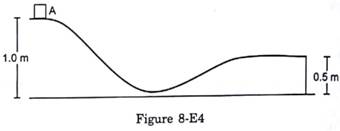Figure (8-E4) shows a particle sliding on a frictionless track which terminates in a straight horizontal section. If the particle starts slipping from the point A, how far away from the track will the particle hit the ground?

Let the mass of the particle be m
Acceleration due to gravity, g = 9.8 m/s2
The height of the particle at point A, h = 1.0 m
Height of particle at the point where it terminates into straight horizontal section, h= 0.5 m
Applying energy conservation on the particle, total initial energy = total final energy
⇒ (Kinetic energy)initial + (Potential energy)initial = (Kinetic energy)final + (Potential energy)final
⇒ 0 + mghat A = 1/2 mv2 + mghat point of termination
⇒ m×9.8×1 = 0.5×m×v2 + m×9.8×0.5
⇒ 9.8 = 0.5v2 + 4.9
⇒ v2 = 9.8
⇒ v = 3.13 m/s
Let the time taken by particle to reach the termination point be t.
The particle starts sliding from rest, from the equation of motion
⇒ h = 1/2 gt2
⇒ 0.5 = 0.5 × 9.8 × t2
⇒ t2 = 0.1020
⇒ t = 0.32 s
∴ The horizontal distance that the particle will travel = speed v × time t
= 3.13 × 0.32
= 1.0016 ≈ 1m